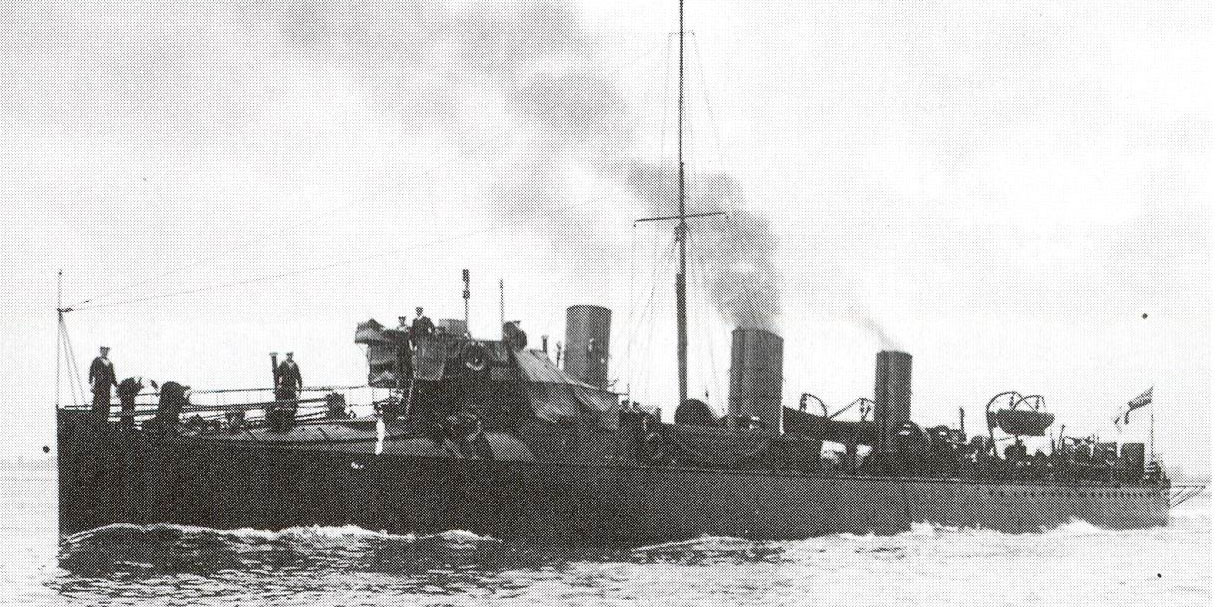ARTHUR UPTON
Stoker, 1st Class, K6305, Royal Navy, Chatham
Died 1 May 1915, aged 24, serving on HMS Recruit when she was torpedoed in the North Sea.

HMS Recruit
(click to enlarge)
Arthur Upton was the fifth child and second son of Arthur Henry Upton, born in Forest Row, and his wife Emily Florence Upton, née Blackstone. The Blackstones were a large extended family living in Forest Row and in the 1881 census (Emily) Florence, aged 22, and her sister Carrie, 20, are listed as having "no occupation" and probably ran the household of their father, stonemason John Blackstone, and their five siblings at their home in Chapel Lane. In the same census Arthur Henry, aged 21, is listed as a lodger with John and Martha Blackstone, aged 80 and 71, at Highgate, Forest Row. At that time Highgate was regarded as a hamlet separate from Forest Row and Chapel Lane is one of the roads and twittens that join the two. The census was taken on 3 April and on 23 April Florence married Arthur Henry Upton, a stonemason, at Holy Trinity, Forest Row. They went on to have at least seven children, Florrie, Harry, Edith, Ida, Arthur, Owen and Elsie May.
While Florrie, Harry and Edith, were christened at Forest Row by the 1891 census the Uptons were living in Southborough, Kent, where Arthur junior was born. In the census at 10, Forge Road Arthur senior was listed as a stonemason with "Emily F" his wife and their children Florrie, 9, Harry, 7, Edith, 6, Ida, 3 and Arthur junior aged 1. By 1901 the family, Arthur senior, Florence, and the children Arthur, now aged 11, Owen aged 5 and Elsie May, aged 1 had moved to 19, Forge Road. The older children would have been old enough to be away earning their living but it seems that Ida had died when four years old.
Arthur junior does not appear on the 1911 census with his family; at home in Lingfield, Surrey, are his parents and siblings Edith, Owen and Elsie. Visiting is Florrie, now Weller, having been married for two years. Arthur was by now in the navy, having signed up on 5 April 1910 for twelve years. At the time of recruitment he was a bricklayer's labourer, and was five foot, five and a half inches tall, chest 35½ inches, brown hair, blue eyes and of a ruddy complexion. His height was about that expected of a man of the labouring classes. Working class men growing up in towns were, on average, two inches shorter than Arthur as pollution from coal smoke reduced sunlight and the body's ability to produce Vitamin D.
Although the work as a stoker would have been laborious work and often in near darkness, for a young man like Arthur there was certainty of employment, food and clothing.
His service record showed his ship to be the Pembroke II, then the Indomitable where he was promoted to Stoker 1st Class by the end of 1912. After a while back in the Pembroke he was sent to HMS Recruit on 28 February 1914. Naval shore stations were always called "HMS" and the vessel attached to each one took the name of the shore station. HMS Recruit, attached to HMS Actaeon at Sheerness, is noted as (HMS Actaeon) sic, on some records.
HMS Recruit was launched on 22 August 1896, part of a government programme of "thirty knotters" (30 knots = 34.5 mph), and entered naval service in 1900, the last of her group of five torpedo-boat destroyers. There was apparently difficulty in this class of ship achieving 30 knots, meaning stokers would have to shovel the coal as fast as possible to achieve top speed.
Recruit had a varied naval career in home waters and by the time Arthur Upton joined her was attached to shore station HMS Actaeon as part of the Nore Local Defence Flotilla. On 1 May 1915 she and a sister ship, HMS Brazen, were patrolling the area off the Thames Estuary. At about 30 miles south-west of the Galloper Lightship the HMS Recruit was struck by a torpedo from the German submarine UB6. Recruit broke in two almost immediately and sank. Of the 65 crew 39 men died, among them Arthur Upton. As a stoker in the belly of the ship he would have had a limited chance of escape; those on deck, thrown into the cold North Sea, would be encumbered by heavy uniforms which quickly became waterlogged and would survive only if picked up before hypothermia slowed movement or the woollen clothing dragged them down.

Chatham Naval Memorial
(click to enlarge)
Arthur's body was not recovered. His name is recorded on the Chatham Naval Memorial, a memorial built in a position to act as a landmark for ships at sea.
His page in the church memorial is signed by his mother Florence, by now widowed and living back in Forest Row at Bank View in Chapel Lane. It is not certain that Arthur ever lived in Forest Row but his name is in the book and on the war memorial as his mother and members of his extended family continued to live in the village.
N.B. There does not seem to be a family connection between Arthur Upton and Albert James Upton who also died in the war.
Vivien Hill
8 January 2017
Updated 19 July 2019

